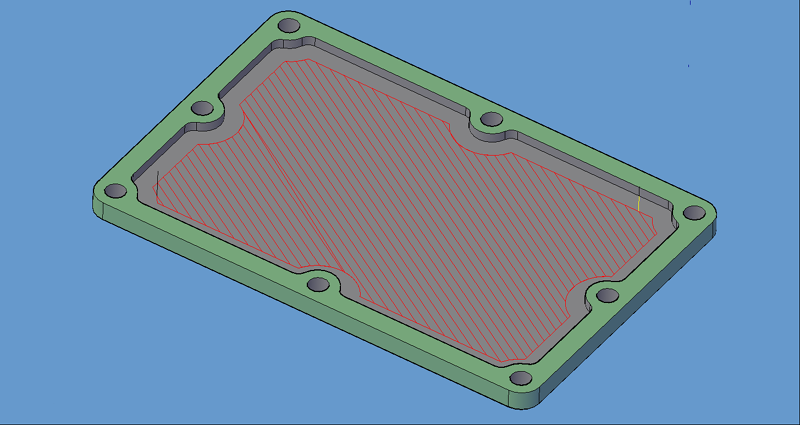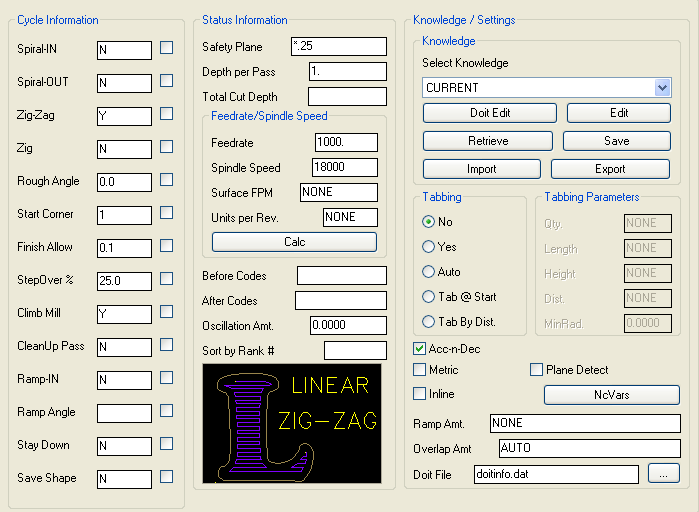|
This version of Linear Pocketing uses a different algorithm and contains many options to control the creation of the tool path than the other Linear Pocketing cycle. This method allows for more complex geometry to be handed to the tool path generator.
Linear Zig-Zag will cut a pocket in a linear, back and forth motion, cutting in both directions. This version of Linear Pocketing has several options in the setup of the cut, such as cut direction, finish pass allowances, and also tool stay down during the cut.
There is a provision for a separate finish pass at the end, which will follow the contour of the entire shape to clean up any tool marks on the edge of the cut.
Note: This cycle is only available on 32-bit Operating Systems. If you are running a 64-bit Operating System, you will be able to use the Advanced Pocketing cutting cycles including Advanced Rest Pocketing. |

Linear ZigZag tool path

Linear Zig Zag parameters.
The following parameters effect the toolpath creation:
The value is not applicable to a Linear Pocket function.
The value is not applicable to a Linear Pocket function.
The value represents that the result cut path will be a linear path that will be connected. The cut path will 'ZigZag' back and forth within the geometry to pocket out the geometry.
The value is not applicable to a Linear ZigZag Pocket function.
To use the Zig function, select the 'Linear Pocket Unidirectional' cycle.
This value represents that angle in which the cut path will be made. The default '0.0' represents that the cut path will follow the 0 degree angle in AutoCAD. This needs to be a real number such as 45.0 or 90.0. The value given is in degrees.
The value is not applicable to a Linear Pocket function.
The value entered here will be added to Finish Pass above to provide material left for a clean up pass on the pocket with a separate tool.
This value is the percentage of the tool diameter between each pass of the tool in the pocket. This needs to be a real number such as 25.0 or 50.0.
The value represents if the cutting cycle will be doing Climb (CCW) milling <Y> or if you want the cutting cycle to do Conventional (CW) milling <N>
A CleanUp Pass is described as an additional tool path that travels around geometry allowing you to use Cutter Compensation for the boundary of the geometry.
A Ramp-In set to <Y> will allow you to have the cutting cycle enter the cut with a ramp instead of a plunge. If this parameter is changed from the default of <N>, then the parameter of Ramp Angle will need to be defined in degrees.
If Ramp-IN is set to <Y>, then this parameter would need to be defined. The parameter will need a numeric value defining the degrees of the ramp such as 30 or 45.
The safety plane is the index plane Z location. If a ' * ' is used as the first character, that position is absolute in world Z coordinates, otherwise it is considered to be the distance above the shape.
This controls the depth per pass in Z. It is also the initial Peck Increment.
This parameter controls the total depth of the cut. If a ' * ' is used as the first character, that position is absolute in world Z coordinates. If it does not, then that distance is considered to be the distance below the initial shape.
Initial feedrate to start the drilling operation.
The RPM value to use for the spindle for this tool path.
Values placed here will be output in the cut cycle before the tool enters the material, typically at the height of the Safety Plane once the tool length compensation is set.
Values placed here will be output in the cut cycle after the tool has retracted from the cut, typically at the height of the Safety Plane after the cut is finished.
A numeric value to use for the tool path created to allow the Sequence to place cuts in a specific order when the code is created.
**Changing values in the cycle parameters may yield unexpected results with some settings or on some geometry. Examine the toolpath and NC Code carefully before running your machine tool if you change these default settings.